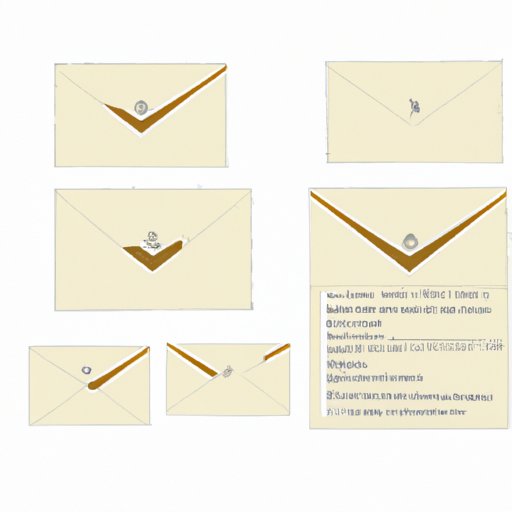
Introduction
Addressing envelopes may seem like a simple task, but it is essential to ensure their timely delivery. Whether you are sending a formal invitation or mailing a letter, knowing how to address envelopes correctly is a basic life skill. This article provides a step-by-step guide on addressing envelopes, tips for addressing formal invitations and envelopes, creative ways of addressing envelopes, addressing business envelopes, and addressing envelopes for international mail so that you can become an envelope addressing pro.
A step-by-step guide on addressing envelopes
Before diving into how to address envelopes, it is important to identify the necessary components of an envelope. An envelope typically consists of the return address, the recipient’s address, and postage. When preparing to address an envelope, ensure that you have all the necessary components at hand.
To start, take a standard-sized envelope and follow these simple steps:
- Write the return address in the top left corner.
- Write the recipient’s name in the middle of the envelope.
- Write the recipient’s address, starting with the house or building’s number and street name, then the city or town name, the state or provincial abbreviation, and the ZIP or postal code.
- Add the postage; the location may vary depending on the type of envelope and postage used.
It is crucial to avoid common mistakes such as placing the return address or recipient’s address incorrectly, writing sloppily, or using illegible handwriting. Illegible handwriting may lead to incorrect delivery or even return to the sender.
Tips for addressing formal invitations and envelopes
Proper etiquette is essential when addressing formal invitations to ensure that the intended message is conveyed. The following are general guidelines that will assist you in addressing formal invitations:
- For weddings, the outer envelope should be addressed to the couple, including their titles and full names, while the inner envelope should only include the first names of the invitees.
- Graduation invitations should include the full name of the recipient, their degree, and the year they graduated.
- For formal dinners, the invitations should be addressed to the household.
Additionally, handling special circumstances when addressing formal invitations may present some challenges:
- When addressing envelopes to unmarried couples, both names should be included on the envelope, separated by “and.”
- In the case of divorced parents, invitations should be sent according to their current names and titles; however, it would be considerate to send two separate invitations to avoid any potential tension.
How to address an envelope using calligraphy
For those seeking to elevate their envelope addressing game, calligraphy provides an excellent option. Calligraphy involves creating lettering with thin and thick strokes, creating an aesthetically pleasing appearance. Here’s how to get started with calligraphy:
- Gather the necessary materials, including a calligraphy pen, ink, and a straight edge to assist with the lettering.
- Practice the lettering styles you would like to use by starting with simple lettering such as the alphabet and shapes.
- When you’re comfortable with the lettering, move on to addressing envelopes by starting with the return address and working your way towards the recipient’s address with graceful strokes.
- Allow the ink to dry completely before handling or mailing the envelope.
Creative ways of addressing envelopes
For those who love to add an artistic or fun flair to their envelopes, there are countless options to explore. From unique fonts to stickers, washi tapes, and more, the options are numerous. A few ideas to get your creativity flowing:
- Experiment with different lettering styles such as cursive or block letters.
- Add stickers, washi tape, or other decorative embellishments.
- Use a different colored ink to add depth and variety to your envelope design.
Remember to keep the recipient in mind, as overly creative envelopes may not always be appropriate for formal situations or professional correspondence.
Addressing business envelopes
Properly addressing a business envelope is vital, as it represents your company’s brand image. Here are some essential tips to keep in mind when addressing business envelopes:
- The return address should be in the top left corner.
- The recipient’s name and company should be written in the center of the envelope.
- The street address of the recipient’s company should be written below the company name, followed by the city, state, and ZIP code.
- Addressing confidential or legal documents should be handled with extra care to ensure that the recipient is the intended person and that the envelopes are correctly sealed for privacy.
Addressing envelopes for international mail
When addressing envelopes for international mail, it is critical to follow specific guidelines to ensure successful delivery to your intended recipient. Here are a few essential tips for addressing international mail:
- Include the name of the recipient and their company if applicable.
- Include the complete street address, followed by the city, region or province, country, and then the postal code.
- Ensure that all essential information is written in the English language and in block letters.
- Include a customs declaration form when sending items internationally, which includes details of the content and the item’s value.
Conclusion
Mastering the art of addressing envelopes can be a significant advantage in professional and personal contexts. By following this comprehensive guide, readers can confidently address envelopes appropriately for various occasions. Remember to take time to practice and get creative with getting your message delivered. With various techniques and styles to explore, addressing envelopes can be another avenue for self-expression.





